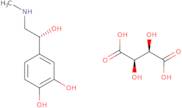(-)-Epinephrine (+)-bitartrate salt
CAS : 51-42-3
Ref. 3D-FE36653
| 1g | Arrêté | ||
| 2g | Arrêté | ||
| 5g | Arrêté | ||
| 10g | Arrêté | ||
| 25g | Arrêté |
Informations sur le produit
- L-Epinephrine D-hydrogentartrate
- (-)-Adrenaline Hydrogen Tartrate
- (-)-Adrenaline acid tartrate
- (-)-Adrenaline bitartrate
- (-)-Epinephrine-(+)-Hydrogentartrate
- (?-Epinephrine (+)bitartrate salt
- 1,2-Benzenediol, 4-[(1R)-1-hydroxy-2-(methylamino)ethyl]-, (2R,3R)-2,3-dihydroxybutanedioate (1:1)
- 1,2-Benzenediol, 4-[(1R)-1-hydroxy-2-(methylamino)ethyl]-, (2R,3R)-2,3-dihydroxybutanedioate (1:1) (salt)
- 1,2-Benzenediol, 4-[1-hydroxy-2-(methylamino)ethyl]-, (R)-, [R-(R*,R*)]-2,3-dihydroxybutanedioate (1:1) (salt)
- 4-[(1R)-1-hydroxy-2-(methylamino)ethyl]benzene-1,2-diol 2,3-dihydroxybutanedioate (salt)
- Voir d'autres synonymes
- 4-[(1S)-1-hydroxy-2-(methylamino)ethyl]benzene-1,2-diol 2,3-dihydroxybutanedioate (salt)
- 4-[1-Hydroxy-2-(Methylamino)Ethyl]Benzene-1,2-Diol 2,3-Dihydroxybutanedioate (1:1)
- <span class="text-smallcaps">L</span>-Adrenaline bitartrate
- Adrenalin bitartrate
- Adrenaline tartrate
- Adrenaline, tartrate (1:1)
- Adrenatab
- Asmatane Mist
- Asthmahaler Epitrate
- Benzyl alcohol, 3,4-dihydroxy-α-[(methylamino)methyl]-, (-)-, (+)-tartrate (1:1) (salt)
- Bronitin Mist
- Bronkaid Mist Suspension
- Epinephrine Acid Tartrate
- Epinephrine Bitartrate
- Epinephrine d-bitartrate
- Epinephrine tartrate
- Epinephrinhydrogentartrat
- Epitrate
- Hidrogenotartrato De Epinefrina
- Hydrogenotartrate d'epinephrine
- L-(-)-Epinephrine-(+)-bitartrate
- Medihaler-Epi
- Primatene Mist Suspension
- R-(-)-Epinephrine bitartrate
- Tartaric acid, compd. with adrenaline
- l-Adrenaline bitartrate
- l-Adrenaline d-bitartrate
- l-Adrenaline hydrogen tartrate
- l-Adrenaline tartrate
- l-Epinephrine d-bitartrate
Epinephrine is a hormone that occurs naturally in the body and is also used as a medication. Epinephrine may be given by injection to increase blood pressure during a severe asthma attack, to relieve bronchospasm, or to make the heart beat faster in order to improve circulation. It is also used as an emergency treatment for cardiac arrest. Epinephrine works by binding to alpha-adrenergic receptors on cells, which results in increased activity of the sympathetic nervous system. This causes an increase in heart rate and blood pressure, while simultaneously dilating air passages and increasing blood flow to the brain.
Epinephrine is typically administered via an autoinjector (e.g., EpiPen) that is designed for emergency use outside of a hospital setting. The most common side effects are high blood pressure and fast heartbeat. Other side effects may include headache, anxiety, dizziness, trouble sleeping, muscle weakness or cramps, shakiness (tremors), nausea





